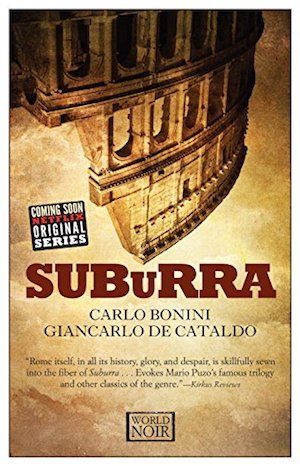
Suburra opens in 1993. A prologue set in the “muggy darkness of a summer night” describes three men poised to rob safety deposit boxes at one of the main branches of the Bank of Rome. They chat, and one tells a story about their boss, Samurai. But after a revealing tale is told and the robbery is successfully pulled off, violence follows and it begets more violence.
The prologue is fantastic and sets the tone for a book where corruption and blood fill the pages like a plague. Bonini and De Cataldo create an atmosphere that feels akin to the work of writer and director Quentin Tarantino. Characters with names like Samurai and Number Eight are bold and fantastically overdrawn and the violence they enact is hyper-real.
We then jump to present day Rome, where the rest of the action takes place. A crooked politician with a penchant for fast living finds himself with a dead prostitute on his hands. He solicits a minor gang member to help him cover it up, and the small time thug attempts to use the power he has over the politician to gain a stronger foothold on the underworld ladder. Instead he winds up dead.
We meet the heroic Marco Malatesta, once a young thug on the streets of Rome now he works for Samurai. But his criminal days are behind him and he has climbed the ranks of the Carabinieri, the national police force, to the rank of Lieutenant Colonel. Malatesta shows he is fearless right away, and effortlessly handles a bad guy on a train platform just like a big-budget action hero. Soon, however, he’s pulled in for the dead thug’s murder and he suspects it is part of something bigger.
The mafia, corrupt politicians, and a new rogue crime element are all jockeying for control of Ostia, a depressed coastal town just outside Rome. One of these groups aims to turn the area into the Las Vegas of Italy, but not all of them will play by the long established rules and a violent chaos ensues.
The main characters in Suburra are terrifically drawn. The world of whores and crooks, gangsters and crooked politicians, makes this a very packed and compelling novel. There is a lot of plot, and subplot, in the 500 pages of Suburra. The story is big and literary but works hard to maintain the excitement we expect from page-turning crime fiction.
The fast moving action sometimes obscures understanding, and it is easy to get lost. The giant cast of characters can be hard to follow and the intricacies of the plot might leave you scratching your head. When we are with secondary characters, which we don’t know as well, the prose still shines but the excitement wanes. Shades of what is going on can be pulled from the text, but you end up feeling a bit out of the narrative loop. The character list in the opening pages is helpful, but having to refer to it often interrupts the flow.
Despite this, Suburra feels fresh, exciting, and new while simultaneously evoking classics of the epic crime fiction genre like Mario Puzo’s Godfather series, and Richard Price’s Clockers. The writing style is fluid, and the book is gripping enough, even if at times it is confusing. The satisfying ending, where all is tied up, makes up for some of the confusion along the way.
Suburra was made into an award winning Italian film last year, and this October the same production company will expand it into a 10-part Netflix series. With high production values, it will be exciting to see Netflix’s first original series in Italian. The book is definitely worth reading before it airs, and you can watch the trailer below.
Click here for more Italian crime fiction.
Europa Editions
Print/Kindle/iBook
CFL Rating: 4 Stars